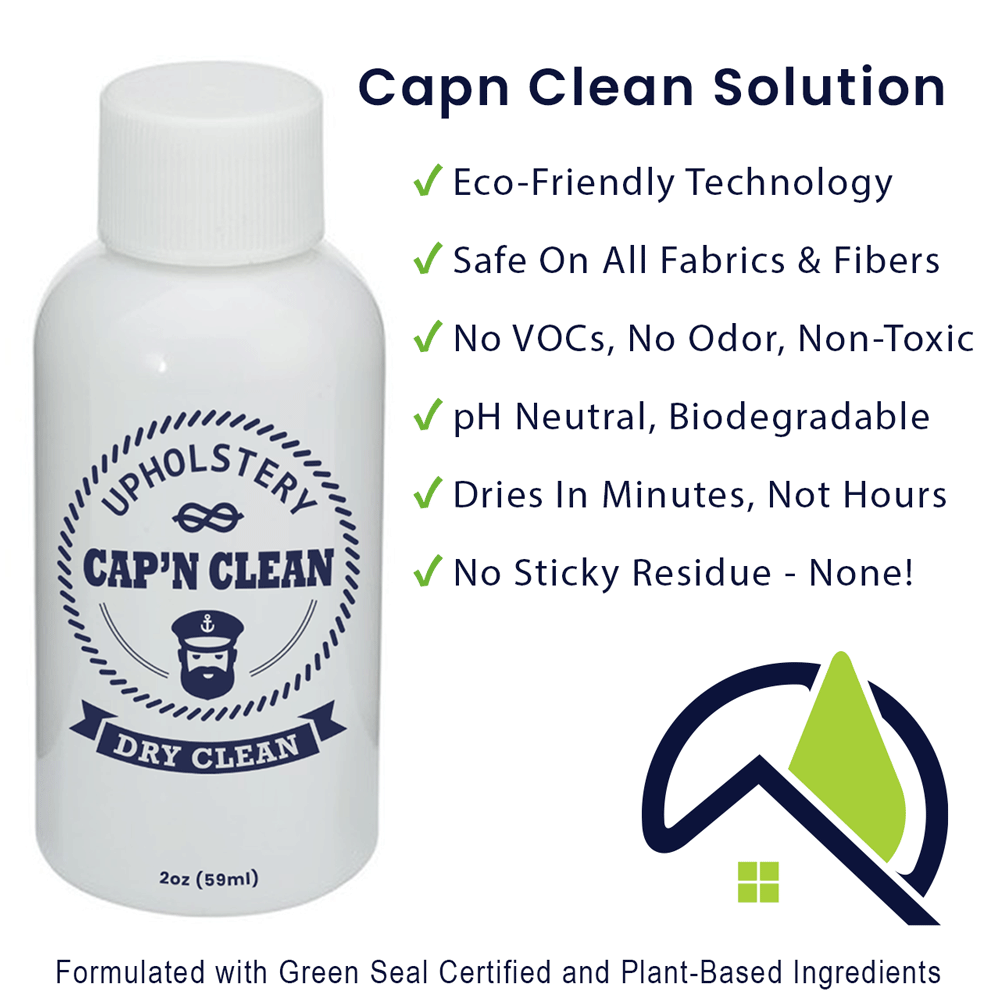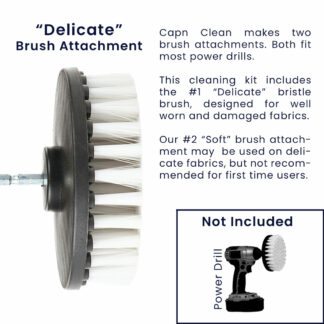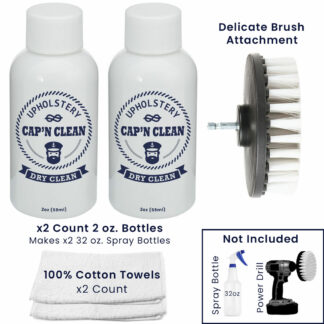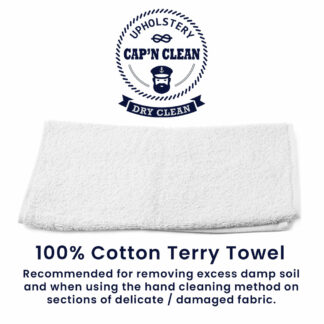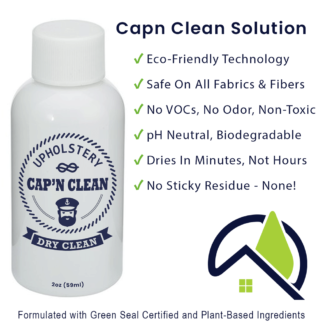Description
One 2 oz. bottle mixed with water makes one 32 oz. spray bottle, capable of cleaning all exposed fabric on a large sectional sofa. This single bottle of Capn Clean concentrate upholstery dry cleaning solution is intended for two types of customers. #1 – Customers that prefer to clean upholstery by hand, using the towel method – recommended on sections of delicate or damaged fabric. #2 – Customers that have already purchased a Capn Clean kit or brush attachment and need a refill bottle.
For the ultimate upholstery and fabric cleaning solution, just add one 2 ounce bottle of Capn Clean concentrate to any clean 32 oz. spray bottle. Fill with water and shake well. Spray a light mist of Capn Clean solution on your fabric stains, spots, and soiled areas. If you do not already have an authentic Capn Clean #1 Delicate or #2 Soft brush attachment, you may use the Hand Cleaning Towel Method to complete the cleaning and stain removal process. You can also purchase a brush attachment separately, right here on our website. We also offer the recommended 100% Cotton Terry Towels
Capn Clean Upholstery Hand Cleaning – Towel Method
We recommend using white or light-colored 100% cotton terry towels so that you can detect soil that is absorbed into the cotton towels. Spray a light mist of Capn Clean solution on spots, stains, and soiled areas of fabric, one section at a time. With the Hand Cleaning – Towel Method, we recommend cleaning a one-square-foot section of fabric at a time. For small spots and stains, two towels should be sufficient. For severe stains and cleaning entire pieces of furniture, more towels will make your job easier. Each towel that you use will remove soil, so having five or ten additional towels on hand will allow you to set the soiled towels aside, only using clean towels, until you remove the entire stained or soiled area of fabric.
Fold your 100% cotton white terry towel twice, making a square. Use one clean section of the dry towel at a time. Use the cotton towel to dab up the dampened fabric, with a lifting action; do not scrub the fabric – you’re trying to lift up the soil into the towel, not push it down into your materials. Check the towel to see if the soil is being transferred to the dry white towel fibers.
If only a small amount of soil is visible on the white towel, spray more Capn Clean solution onto the spot. Less is more. All fabric and soil conditions are different, so our recommendation is to use as little Capn Clean solution as possible, gradually increasing the amount that you spray onto the fabric until you see maximum soil transfer into the white terry towel.
If you apply too much Capn Clean solution to a stained or heavily soiled area, some of the liquid will sink into your materials, weighing down soil particles with too much moisture. On the other hand, if you do not apply enough solution, your cotton towel will not be able to absorb the optimal amount of soil. If you gradually increase the amount of solution sprayed onto your fabric, you will quickly determine the optimal amount of solution to be applied, for your specific soil and fabric conditions.
If you over-wet a section of fabric, no problem – just use a clean and dry portion of your cotton towel to absorb the excess moisture and you will see the soil transfer into the dry towel fibers. Then, repeat this step with another section of the dry towel.
As you continue to repeat the above steps, lifting up soil and stains with your dry cotton towels, you will notice that less and less soil transfers into your towel. This is easier to determine if you are using white 100% cotton terry towels. As stains disappear, don’t stop cleaning! You should continue this process until no visible soil transfers into your clean white towel.
Other upholstery cleaning solutions and shampoos are basically a mixture of chemicals and sticky residues. The chemicals break down soils, while the sticky residues trap the soil particles. The problem is that it is nearly impossible to remove all of those sticky residues from fibers and fabrics. All of that residue remains in your materials, which acts like a glue coating on your fabric, attracting new soil like a magnet, and will typically alter the texture and softness of your fabrics. Upholstery cleaning shampoos and detergents also tend to chemically damage fine fabrics, in many cases altering the color.
Portable upholstery cleaning machines would be a great idea, but your sofas, loveseats, and upholstered chairs are not equipped with drains, so a lot of the mixture of soil, water, and chemicals inevitably sink deep down into your materials. Over a period of several days, this deep-down moisture evaporates back up to the surface, carrying contaminants, chemical pollutants, bacteria, and other microorganisms back up to the surface. The excess moisture also produces a damaging oxidizing effect during the evaporation process.
Think of a slightly damp, relatively clean towel left to hang dry on a towel rack. The next day you might notice that the texture of the towel is stiff and somewhat sticky, as a result of chemical changes and microbes growing in the damp soft materials. The same is true for furniture upholstery cleaning machines, but these machines leave behind substantially more moisture and the food source for microbial populations is much greater. Wet cleaning upholstery, in many cases, will actually leave your materials in a more unsanitary condition than prior to cleaning them. All of that water sitting in your materials is just disgusting from an interior home hygiene standpoint.
Upholstery cleaning machines, spot remover machines, and portable household carpet cleaning machines all do a great job of rinsing and flushing soils and residues, but many of the soil particles (microbial food source), and chemicals (shampoos, detergents, surfactants) are actually flushed down into your materials. The visible surface of the fabric may look clean, but liquid water delivered into the fabric with pressurized jets is the first step of any portable upholstery cleaning machine, whether a professional-grade machine or a consumer product made by vacuum manufacturers.
In the first step, high-pressure streams of water are forced into your materials. In the second step, the machine’s vacuum uses suction to capture liquified soil that remains at or near the top layer of materials, meanwhile, a substantial amount of soil, chemicals, and contaminants are flushed deep down into your furniture, where it is no longer visible. As the moisture evaporates, invisible droplets of water wick back up to the surface, towards the heavens, carrying many of the contaminants that were flushed down.
These contaminants may not always be visible, especially in sofa cushions, where dirty water can be flushed deep enough to disperse microscopic soil particles in a scattered pattern. In some cases, however, “stain wick back” will occur, where remnants of the stain will reappear on the fabric surface days or weeks later.
The day after wet upholstery cleaning using a portable machine, your upholstered fabric may feel dry to the touch, but deep down moisture remains in cushioning materials. It can take several days or weeks for all of that excess moisture to evaporate and that is how “stain wick back” occurs – microscopic soil particles and contaminants literally carried back up to the fabric surface during the often lengthy evaporation process.

